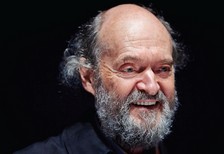
Arvo Pärt (b. 1935, Estonia) is the most famous Estonian composer. Since the late 1970s, Pärt has worked in a minimalist style employing his self-invented compositional technique, tintinnabuli. His music is in part inspired by Gregorian chant. His major works include the violin concerto Tabula rasa (1977), Cantus in Memory of Benjamin Britten (1977), Sieben Magnificat-Antiphonen (1988) and The Beatitudes (1991). Pärt was the most performed living composer in the world for five consecutive years.
Pari intervallo (On equal distance, 1976/1980) is one of the first seven compositions made in Pärt’s well-known tintinnabuli style. The composer wrote it for four unspecified wind instruments, but later reworked it for the organ. The title partly reflects the compositional technique: in four-part polyphony, the alto is the main melodic part, moving diatonically and mostly stepwise. The bass shadows it from below, always at an equal distance (two octaves and a third). The soprano and the tenor are the tintinnabuli parts, circling around the melodic parts and using only the notes of the main triad. This brief description does little justice to the sombre, elegiac beauty of the piece that at once envelopes the listener. Pärt’s compositional system insists on tonality, but divorces it from harmonic functionality. The harmony is not supposed to take the listener ‘somewhere’ and lead him ‘back’; rather, it stays put, enabling the listener to explore it. Renowned for his spirituality, Pärt views the polarity between the melodic and tintinnabuli lines in terms of the duality of flesh, mortality, and Earth on one side, and spirit, eternity, and Heaven on the other.


